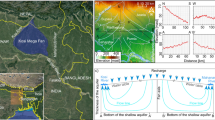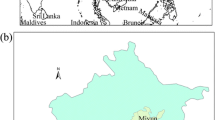Abstract
The most difficult water resources management challenge in the Ganges Basin is the imbalance between water demand and seasonal availability. More than 80 % of the annual flow in the Ganges River occurs during the 4-month monsoon, resulting in widespread flooding. During the rest of the year, irrigation, navigation, and ecosystems suffer because of water scarcity. Storage of monsoonal flow for utilization during the dry season is one approach to mitigating these problems. Three conjunctive use management strategies involving subsurface water storage are evaluated in this study: Ganges Water Machine (GWM), Pumping Along Canals (PAC), and Distributed Pumping and Recharge (DPR). Numerical models are used to determine the efficacy of these strategies. Results for the Indian State of Uttar Pradesh (UP) indicate that these strategies create seasonal subsurface storage from 6 to 37 % of the yearly average monsoonal flow in the Ganges exiting UP over the considered range of conditions. This has clear implications for flood reduction, and each strategy has the potential to provide irrigation water and to reduce soil waterlogging. However, GWM and PAC require significant public investment in infrastructure and management, as well as major shifts in existing water use practices; these also involve spatially-concentrated pumping, which may induce land subsidence. DPR also requires investment and management, but the distributed pumping is less costly and can be more easily implemented via adaptation of existing water use practices in the basin.




Similar content being viewed by others
References
Abadia R, Rocamora C, Ruiz A, Puerto H (2008) Energy efficiency in irrigation distribution networks I: theory. Biosyst Eng 101:21–27
Ala Eldin MEH, Sami Ahmed M, Gurunadha Rao VVS, Dhar RL (2000) Aquifer modelling of the Ganga-Mahawa sub-basin, a part of the Central Ganga Plain, Uttar Pradesh, India. Hydrol Process 14:297–315
Bandyopadhyay J (1995) Water management in the Ganges-Brahmaputra basin: emerging challenges for the 21st century. Int J Water Resour Dev 11:411–442
Baxter RM (1977) Environmental effects of dams and impoundments. Annu Rev Ecol Syst 8:255–283
Bourg ACM, Bertin C (1993) Biogeochemical processes during the infiltration of river water into an alluvial aquifer. Environ Sci Technol 27:661–666
Bouwer H (2000) Integrated water management: emerging issues and challenges. Agric Water Manag 45:217–228
Bouwer H (2002) Artificial recharge of groundwater: hydrogeology and engineering. Hydrogeol J 10:121–142
Bredehoeft JD, Young AR (1983) Conjunctive use of groundwater and surface water for irrigated agriculture’ risk averson. Water Resour Res 19:1111–1121
Camnasio E, Becciu G (2011) Evaluation of the feasibility of irrigation storage in a flood detention pond in an agricultural catchment in Northern Italy. Water Resour Manag 25:1489–1508
Chaturvedi MC, Srivastava VK (1979) Induced groundwater recharge in the Ganges Basin. Water Resour Res 15:1156–1166
Coe J (1990) Conjunctive use-advantages, constraints, and examples. J Irrig Drain Eng 116:427–443
Doussan C, Poitevin G, Ledoux E, Detay M (1997) River bank filtration: modelling of the changes in water chemistry with emphasis on nitrogen species. J Contam Hydrol 25:129–156
Flint AL, Ellett KM (2004) The role of the unsaturated zone in artificial recharge at San Gorgonio Pass, California. Vadose Zone J 3:763–774
Galloway DL, Burbey TJ (2011) Review: regional land subsidence accompanying groundwater extraction. Hydrogeol J 19:1459–1486
Gandhi VP, Bhamoriya V (2011) Groundwater irrigation in India: growth, challenges, and risks. In: India infrastructure report 2011 water: policy and performance for sustainable development. Oxford University Press, New Delhi, pp 90–117
Garduño H, Foster S (2010) Sustainable groundwater irrigation approaches to reconciling demand with resources. Strategic overview series; no. 4. World Bank, Washington, DC
Gopal B, Chauhan M (2006) Biodiversity and its conservation in the Sundarban Mangrove ecosystem. Aquat Sci 68:338–354
Government of India (1997) Report of the groundwater resource estimation committee: Groundwater resource estimation methodology. Ministry of Water Resources. Government of India, New Delhi
Gupta H (1992) Reservoir-induced earthquakes. Elsevier, Amsterdam
Hamner S, Tripathi A, Mishra RK et al (2006) The role of water use patterns and sewage pollution in incidence of water-borne/enteric diseases along the Ganges river in Varanasi, India. Int J Environ Health Res 16:113–132
Harbaugh BAW, Banta ER, Hill MC, Mcdonald MG (2000) MODFLOW-2000, The U.S. Geological Survey modular ground-water model -user guide to modularization concepts and the ground-water flow process U.S. Geological Survey Open-File Report 00–92
Immerzeel WW, van Beek LPH, Bierkens MFP (2010) Climate change will affect the Asian water towers. Science 328:1382–1385
Jarvis A, Reuter HI, Nelson A, Guevara E (2008) Hole-filled seamless SRTM data V4, International Centre for Tropical Agriculture (CIAT), available from http://srtm.csi.cgiar.org
Kundzewicz ZW, Hirabayashi Y, Kanae S (2010) River floods in the changing climate -observations and projections. Water Resour Manag 24:2633–2646
Michael HA, Voss CI (2009a) Estimation of regional-scale groundwater flow properties in the Bengal Basin of India and Bangladesh. Hydrogeol J 17:1329–1346
Michael HA, Voss CI (2009b) Controls on groundwater flow in the Bengal Basin of India and Bangladesh: regional modeling analysis. Hydrogeol J 17:1561–1577
Mirza MMQ (1998) Diversion of the Ganges water at Farakka and its effects on salinity in Bangladesh. Environ Manag 22:711–722
Mishra DK (1997) The Bihar flood story. Econ Polit Wkly 32:2206–2217
O’Hare G (1997) The Indian Monsoon Part 2: the rains. Geography 82:335–352
Pavelic P, Srisuk K, Saraphirom P et al (2012) Balancing-out floods and droughts: opportunities to utilize floodwater harvesting and groundwater storage for agricultural development in Thailand. J Hydrol 470–471:55–64
Planning Commission (2007) Uttar Pradesh development report, vol 2. Government of India, New Delhi
Raut AK (2009) Preparation of Ghaghra Gomti Basin plans & development of decision support systems. Final report Ghaghra Gomti Basin Water Resource Master Plan. State Water Resources Agency UP. Government of India, Lucknow
Revelle R, Lakshminarayana V (1975) The Ganges water machine. Science 188:611–616
Robinson D (2002) Construction and operating costs of groundwater pumps for irrigation in the riverine plain. CSIRO Land and Water, Technical Report 20/02
Sahu P, Sharma R (2012) India considers Diesel, Kerosene price increase. The Wall Street Journal, December 27. http://online.wsj.com/article/SB10001424127887324669104578204703784680388.html. Accessed 27 December 2012
Sakthivadivel R, Chawla, AS (2002). Innovations in conjunctive water management: artificial recharge in Madhya Ganga Canal Project. IWMI-TATA Water Policy Research Program Annual Partners’ Meet, 2002, Vallabh Vidyanagar, Gujarat, India
Shamsudduha M, Taylor RG, Ahmed KM, Zahid A (2011) The impact of intensive groundwater abstraction on recharge to a shallow regional aquifer system: evidence from Bangladesh. Hydrogeol J 19:901–916
Singh A, Nath Panda S, Flugel W-A, Krause P (2012) Waterlogging and farmland salinisation: causes and remedial measures in an irrigated semi-arid region of India. Irrig Drain 61:357–365
Soman MK, Kumar KK (1990) Some aspects of daily rainfall distribution over India during the south-west monsoon season. Int J Climatol 10:299–311
Uitto JI, Duda AM (2002) Management of transboundary water resources: lessons from international cooperation for conflict prevention. Geogr J 168:365–378
Umar A, Umar R, Ahmad MS (2001) Hydrogeological and hydrochemical framework of regional aquifer system in Kali-Ganga sub-basin, India. Environ Geol 40:602–611
UNDP (2006) Managing transboundary waters. In: Human development report 2006, Beyond scarcity: power, poverty and the global water crisis. pp 202–231
World Bank (2010) Deep wells and prudence- towards pragmatic action for addressing groundwater overexploitation in India. World Bank, Washington DC
Acknowledgments
This work was funded by The World Bank South Asia Water Initiative (SAWI). The authors thank Natalie Giannelli, Marcus Wijnen, Jorge Jose Escurra and Hrishikesh Patel of the World Bank for support and GIS data. We thank Sean Krepski (University of Delaware) for helpful editing, and Alan McDonald (British Geological Survey) and two anonymous reviewers for suggestions that greatly improved the manuscript.
Author information
Authors and Affiliations
Corresponding author
Electronic supplementary material
Below is the link to the electronic supplementary material.
ESM 1
(DOC 1.30 mb)
Rights and permissions
About this article
Cite this article
Khan, M.R., Voss, C.I., Yu, W. et al. Water Resources Management in the Ganges Basin: A Comparison of Three Strategies for Conjunctive Use of Groundwater and Surface Water. Water Resour Manage 28, 1235–1250 (2014). https://doi.org/10.1007/s11269-014-0537-y
Received:
Accepted:
Published:
Issue Date:
DOI: https://doi.org/10.1007/s11269-014-0537-y




